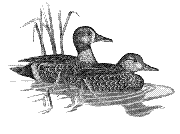US Fish & Wildlife Service
Date of this Version
January 1990
Abstract
The ecology, behavior, and life history strategies of waterfowl are inseparably linked to that unique avian attribute, feathers. Waterfowl rely on flight capabilities to migrate, to fully exploit the resources of wetland and upland communities, and to escape life-threatening events. The insulation provided by contour and down feathers allows waterfowl to use a wide range of habitats and protects them from temperature extremes. Plumage is important not only for species recognition during courtship, but also for cryptic coloration of females during incubation. However, feathers become worn and must be periodically replaced. The process of feather renewal, or molt, is a critical event in the lives of birds. Despite the obvious importance of the molt, relatively little attention has been devoted to managing waterfowl during this period.
Unlike most birds, ducks, geese, and swans share the unusual trait of a complete, simultaneous wing molt that renders them flightless for 3 to 5 weeks during the post-breeding period. Concurrently, these waterfowl also renew their tail and body feathers. In addition to this post-breeding molt, ducks undergo a second yearly molt to renew all but their flight feathers. Here, I describe the nutrition, energetics, and management of molting adult ducks and geese, with emphasis on the period of molt when birds are flightless.



Comments
Published in Diana H. Cross and Paul Vohs (eds.) Waterfowl Management Handbook. Fort Collins, CO: U.S. Fish and Wildlife Service, 1988. Online at http://www.nwrc.usgs.gov/wdb/pub/wmh/contents.html